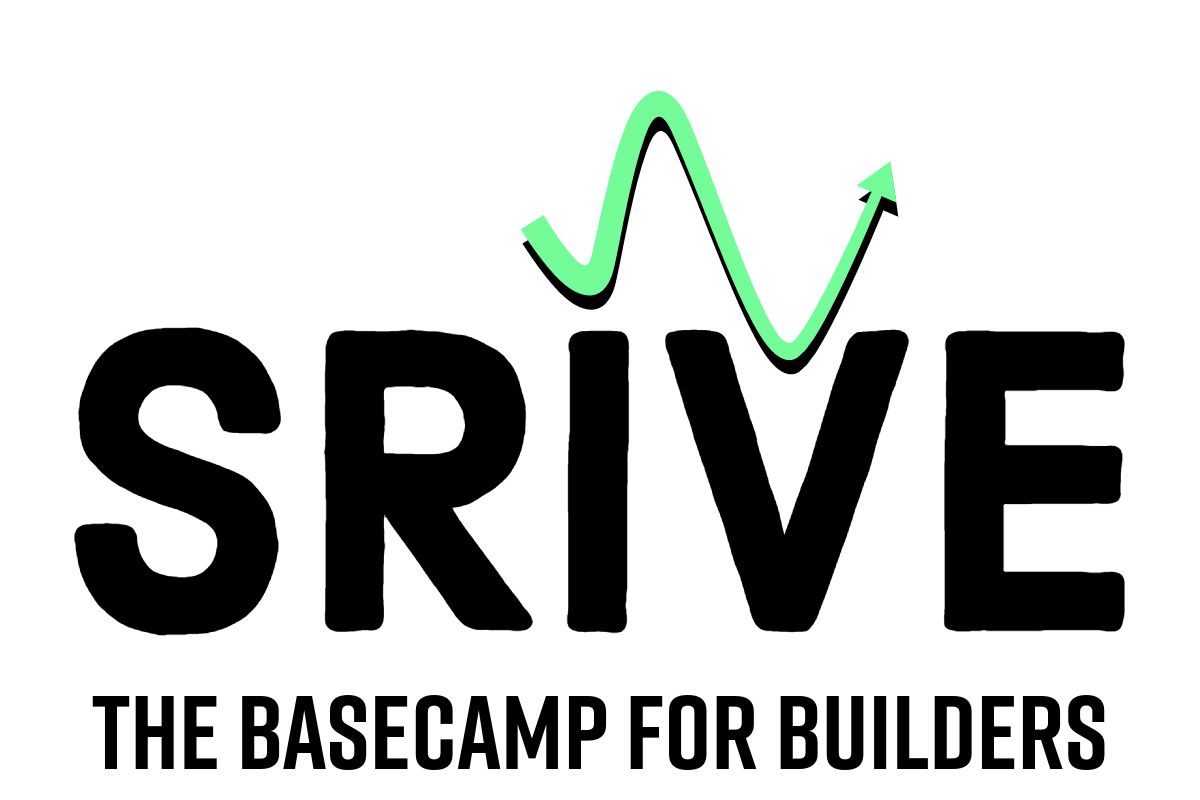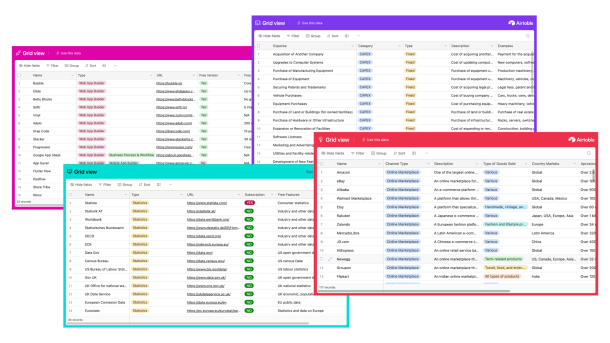Customer Analysis Guide
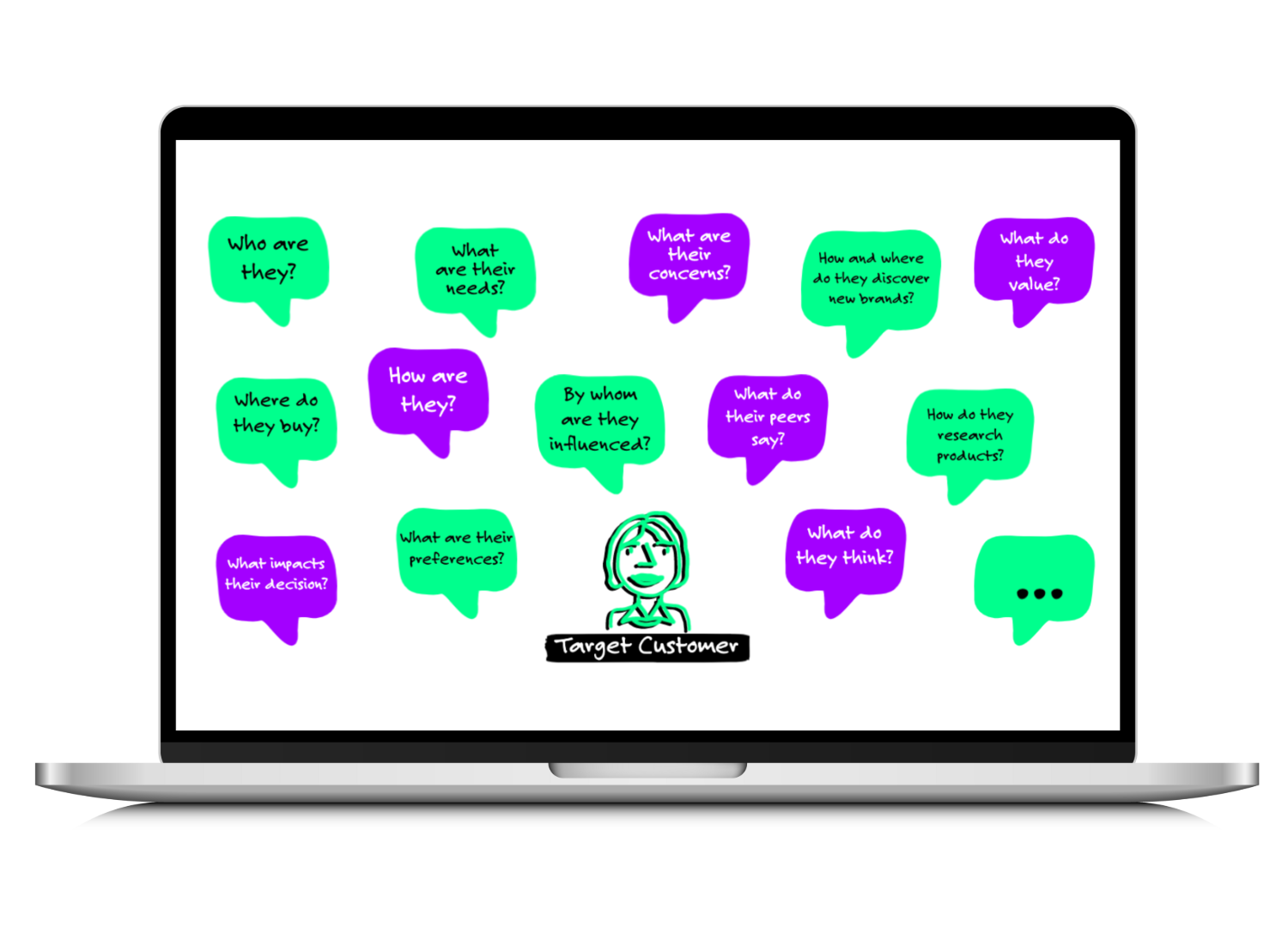
What is a Customer Analysis?
This guide is all about your potential customers. Within the following steps we will in a first step define your target customer segments (if you didn’t do so yet) and then go a level deeper and study your customers in more detail.
In this process you will study and evaluate your target customers’ behavior, preferences, and needs. Understanding the needs and preferences of your customers is essential to create more effective and tailored products and services, and build an overall customer experience your client will love. It also enables you to identify patterns and trends in customer behavior, which can then be utilized to make more informed decisions regarding product development, marketing, and sales.
In short, you essentially want to:
- Detail who and how your target customers are and describe them as a customer persona.
- Understand and describe their consumption behavior and preferences.
- Understand and describe their problems and needs.
So let’s get to it and study your target customer in detail.
Note: 🍋 Throughout this toolkit, we will use the example of a food supplement company to better illustrate each task and information.
What is a Customer Analysis Good For?
Understanding your customers is crucial, as it enables you to create tailored products and services, build a positive customer experience, and make informed decisions regarding product development, marketing, and sales. An in-depth customer exploration will help you to achieve:
- Tailored Products and Services: Gain insights to create products and services aligned with customer preferences.
- Effective Marketing Strategies: Develop targeted marketing campaigns based on customer behavior and interests.
- Improved Customer Experience: Build an overall customer experience that resonates with your target audience.
- Market Trends Identification: Identify patterns and trends in customer behavior, staying ahead of market changes.
Curated Lists 📋
💡 To save you some time, we have prepared a free list with Statistics & Data Resources, a Survey Question Format Glossary and a free list Customer Research Tools with which you can use for your Customer Analysis.
How to Conduct a Customer Analysis Step-by-Step:
Step A: Customer Deep Dive Template
Step B: Target Segments
Step C: Customer Data Research
Step D: Customer Personas
Step E: Empathy Map
Step F: Customer Journey
Step G: Market Research (optional)
Step A
Customer Deep Dive Templates
To work on your customer analysis you can either build your own whiteboard template for example on Miro and use Google Sheets to design your survey, or you can use our ready-to-use templates along with this guide.
Included Templates:

Customer Analysis Miro Board
Customer Survey Design Spread Sheet
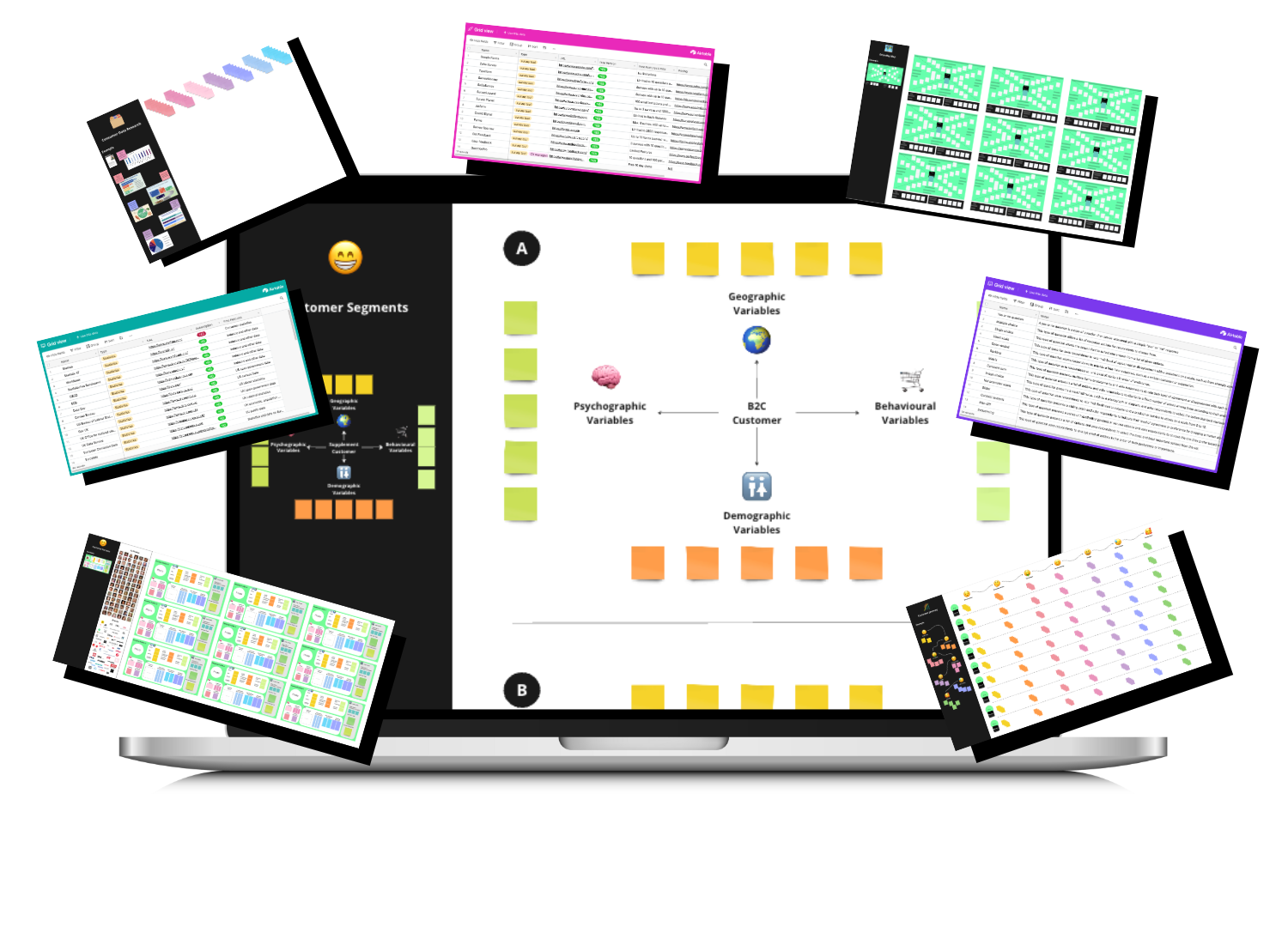
Step B
Customer Segments

In case you didn’t do this yet, the first step is to determine which customer segments you are going to target and serve with your products/services. Depending on your business you might sell very generic products/services and serve a broad range of customer segments, or you are operating in a very specific niche that serves only a few customer segments.
Whatever it is, you should make sure you are clear about who it is that you are targeting, since this information will also be needed later to estimate the size of your market.
The first essential differentiation you will have to make is, if you are going to serve B2B clients, meaning other businesses or if you are targeting B2C customers, meaning consumers, or maybe both.
To further narrow down your target customers, you want to use a number of segmentation variables. The relevance of the different variables can of course vary depending on your industry and the products/services you are selling, but there are some typical ones that will usually apply to the majority of businesses, we will look at them in a minute.
The types of variables will slightly differ for B2B and B2C segments, but one very key variable applies to both, namely the country market your future customers are located in. The country or countries you want to sell to will heavily impact all the other elements of the market environment analysis (competitors, barriers to entry, suppliers and the socio-, economic- and political environment).
However, let’s get started and look into the segmentation variables for each.
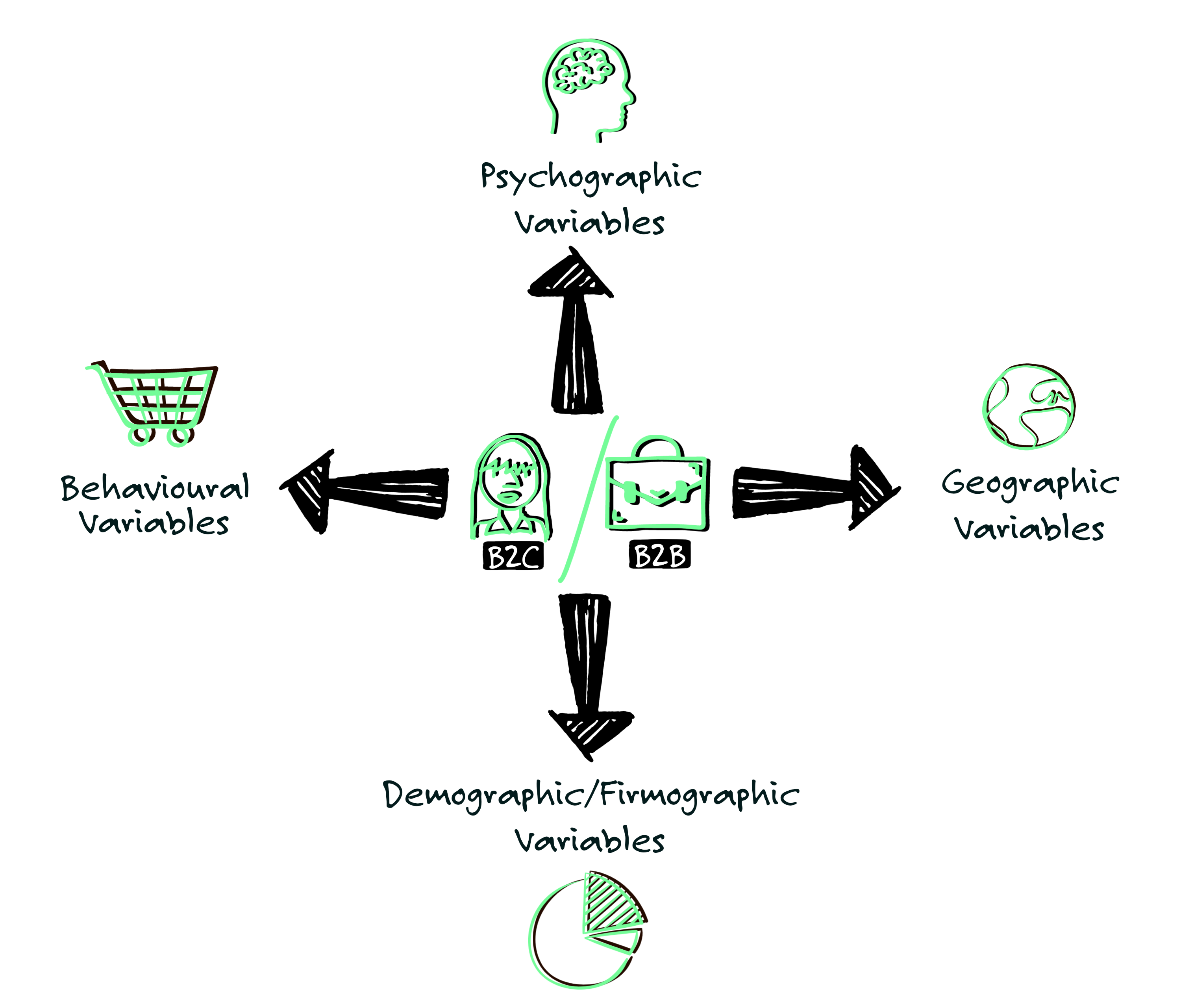
B2C (End User) Customers
🌍 Geographic variables: Are used to segment your customers by location, this can be on a higher level by region (e.g. EMEA), by country, or on a more detailed level if you only serve people in certain states, or cities. You can also differentiate if your target customers are located in rural or urban areas.
-
- Region
- Country
- State
- City
- Urban or rural areas
🙂 Demographic variables: Are used to segment your customers by observable people-based characteristics. Demographic segmentation is one of the most common types and demographic data on the population is quite easily available from public census records. Types of demographic data include:
-
- Gender
- Age
- Marital status
- Family size
- Income level
- Occupation
- Education Level
🛒 Behavioral variables: Are used to segment your customers by their shopping behavior, these variables are a little more complex since they are, A. no hard facts like your customers’ location or age and B. vary depending on the type of product (for example the shopping behavior for a car differs heavily from the one for cosmetic products). Think about the product/service you would like to offer. How would the ideal purchasing behavior look in your case? Behavioral variables for example include:
-
- Shopping channel – Where do they usually shop and search for products? Offline, on the web, on mobile?
- Shopping frequency – How often would they shop for your products habitually, seasonally, occasionally
- User status – How experienced are they using this type of product, are they new users, occasional users, regular users or expert users?
- Decision making – How do they decide which products to purchase, based on price, quality, brand status etc.?
🧠 Psychographic variables: Are used to segment by their personal characteristics. Just as the behavioral variables, psychographic ones are quite complex and not easy to categorize since they vary heavily on an individual level. At this point it is not about figuring out exactly who your potential customers are, but rather about painting a rough picture of the type of people who would be using your product/service. Those variables for example include:
-
- Lifestyle – How do your target customers live? Are they jetsetters, or small town family people, do they live a very active and healthy life or spend their time reading and watching TV?
- Interests – What are their hobbies? What do they like to do in their freetime? Are they into fashion? Do they like sports? Are they artsy?
- Values – Which values do they represent and live by? Do they look after the environment? Are they looking for popularity or uniqueness? Do they value reliability or honesty?
B2B (Business) Customers:
🌍 Geographic variables: Are also used for B2B clients to segment them by location, this can be on a higher level by region (e.g. EMEA), by country, or on a more detailed level if you only serve businesses in certain states, or cities. You can also differentiate if your target clients operate in rural or urban areas.
-
- Region
- Country
- State
- City
- Urban or rural areas
🏢 Firmographics variables: Are the B2B counterpart to demographic variables and are used to segment your clients by observable company-based characteristics. You also commonly find data on public records and company databases. Types of firmographic data include:
-
- Company size – How many employees (range) do your target clients have? Are they entrepreneurs, small businesses, medium businesses or large corporations?
- Company revenues – In which revenue range are they, how much do they make on average in a year?
- Industry/sector – in which sectors do your target clients operate in?
- Company age – Are your target clients young startups, established modern companies born in the last 20 years or old traditional companies with a long history?
🛒 Behavioral variables: Just as for B2C customers, these variables are used to segment your B2B clients by their purchasing behavior. Also in this case these variables are a little more complex since they are A. no hard facts like your customers location or age and B. vary depending on the type of product. Think about the product/service you would like to offer. How would the purchasing behavior of your clients look in your case? Behavioral variables for example include:
-
- Shopping channel – Where do they usually shop and search for products? Through direct consultation with a sales person, their network or through online channels?
- Shopping frequency – How often would they shop for your products? Habitually, seasonally, occasionally?
- User status – How experienced are they using this type of product? Are they new users, occasional users, regular users or expert users?
- Decision making – How do they decide which products to purchase? Based on price, quality, brand status etc.? And who is the decision maker, is it IT, Marketing, Maintenance?
- Switching cost – How likely and easily can they switch to a new provider? Are switching costs rather high or low? (It is for example easier to switch to a new marketing agency than to change to a whole new enterprise software)
🧠 Psychographic variables: Just as for individual people we can also use psychographic variables to segment businesses by their individual characteristics. Again those variables are rather complex and not easy to categorize, since they vary heavily on an individual business level. At this point it is not about figuring out exactly who your potential clients are, but rather about painting a rough picture of the type of businesses that would be using your product/service. Those variables for example include:
-
- Working style – How do they work, are they young and digital companies that embrace remote working or do they like to work from an office and hold in-person meetings? Are their processes longsome and well analyzed or are they fast and dynamic?
- Company culture – What type of company culture do your target clients embrace, modern or traditional? Are they structured and strict or open and casual?
- Company values – Which company value do your clients represent? Are they environmentally friendly, digital and innovative, engaged in society etc.?
☝️Based on those segmentation variables, use the first section in your Customer Deep Dive 📒Template to think about how your ideal target customers would look like and describe them using the post-its.

Step C
Customer Data Research

Next, you should dedicate some time to research and understand available customer data. The objective at this point, again, is not to conduct an elaborated analysis of all the customer data, but rather to gain some high level information that helps you later to describe who your customers are and how they consume.
If your business has been existing for a while, you probably already collected some type of customer data. This can include data on customer demographics, data on past purchases, customer feedback, as well as data from market research and surveys.
If you are creating a new business and don’t have any customer data available yet, don’t worry, take some time to Google for data on consumer statistics. You can for example search for:
- Consumer survey [YOUR SECTOR/PRODUCT/SERVICE]
- Consumer data [YOUR SECTOR/PRODUCT/SERVICE]
- [YOUR TARGET SEGMENT] consumption habits/behavior
- Statistics on [YOUR SECTOR/PRODUCT/SERVICE] consumption
- …
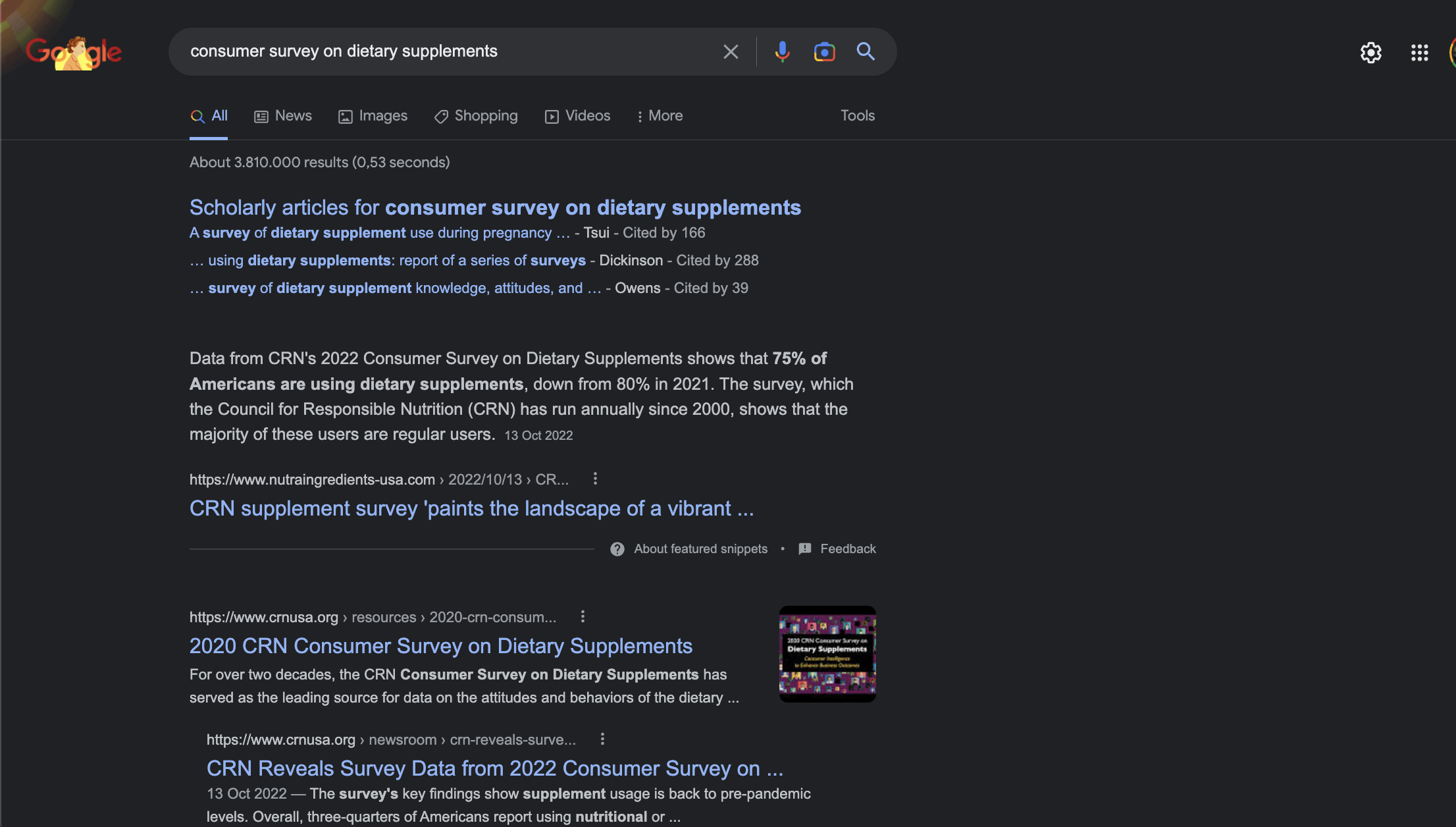
🍋 Food Supplement Example
In our example, we used the search term “consumer survey on dietary supplements”
💡 There are also a number of institutions that provide public data sets, including consumer and industry data, which you can search for information. You can find a number of sources on your Data & Statistics Resources List above.
Types of information you want to look for can be:
- Detailed demographic data
- Detailed geographic data
- Purchase/consumption frequency
- Purchasing channels
- Search/information channels
- Decision-making factors and influencers
- Online/offline places your target segment visits frequently
- Average spend on the product/service category
- Price elasticity, willingness to pay of your target segment
- Reasons (needs) for purchase/consumption
☝️ Take an hour or two, to research and note down your key findings, include links to the sources, screenshots of statistics etc. on your Customer Deep Dive 📒Template.
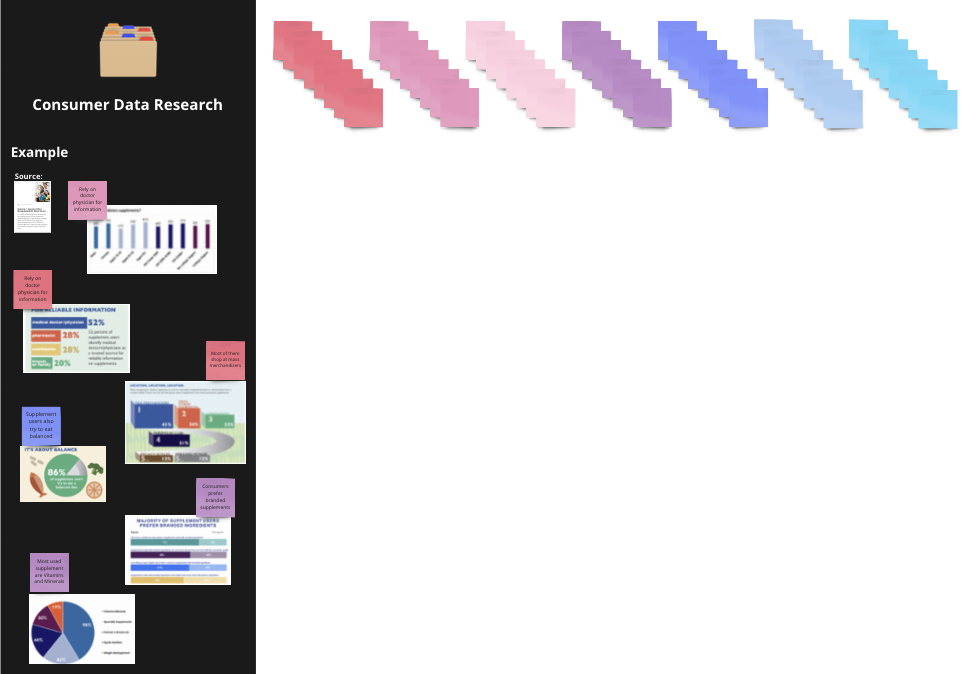
Step D
Customer Personas

Now comes the fun part, where you will have to get creative and imagine your customer personas. A customer persona, sometimes also called user or consumer persona, is a fictional representation of your ideal customer. A customer persona typically includes details such as the customer’s age, gender, income level, interests, and pain points. This information will help you to create your product development strategies that are tailored to the specific needs and preferences of your target customers and define marketing campaigns that are more efficient.
If you are a very niche provider, you may only have one specific customer persona, but usually you will have several types of personas that fit within your target segment.
So go ahead, put yourself into the skin of your target customers and imagine who and how they are. Think of people you know or even ask them and build a profile for each persona.
You can use the persona description for B2C as well as for B2B customers. In the case of B2B customers, really think of the actual person that would purchase and/or use your product within a company.
We prepared a persona map on your Customer Deep Dive 📒Template where you can describe your ideal customer using the following elements:
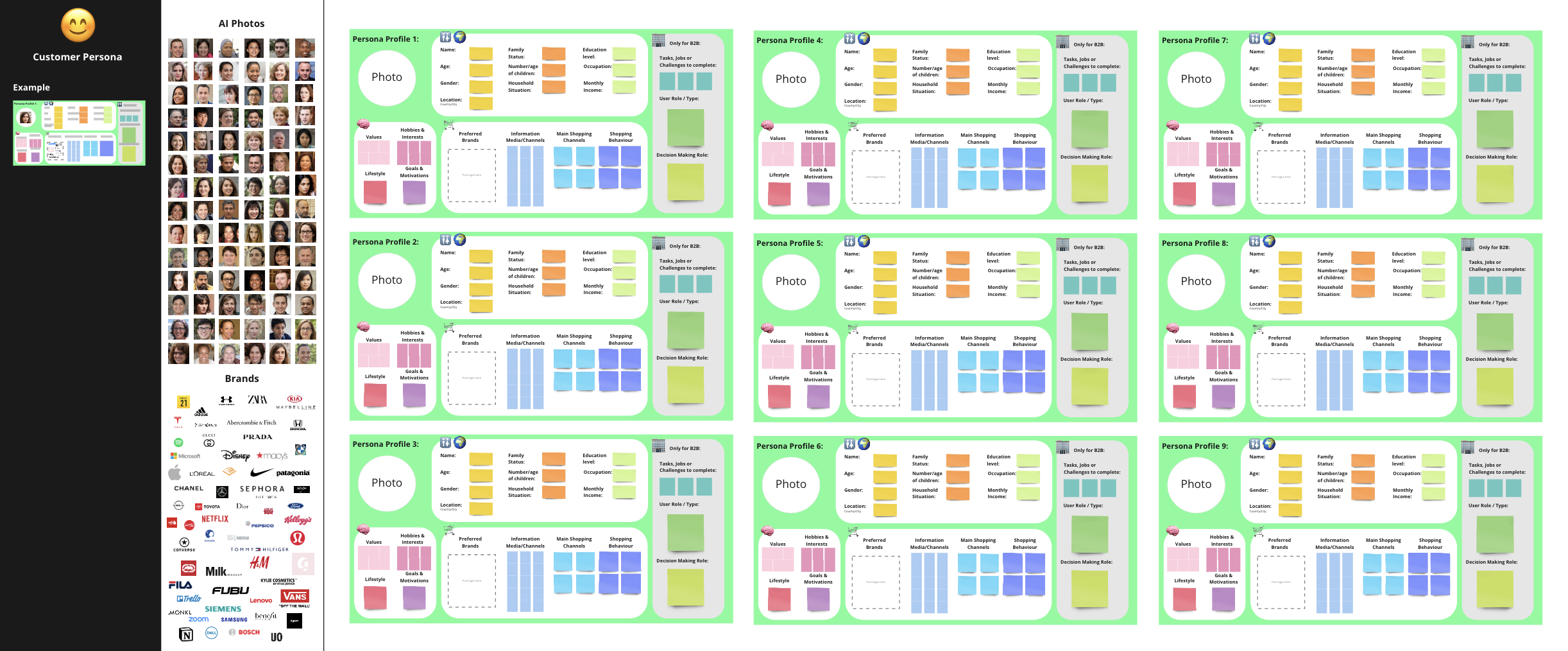
Demo- and Geographic Information
- Photo: Give your customer persona a face. Select a photo of someone that shows how your target customer could look like. You can select from the example photos on the whiteboard or search your own. At thispersondoesnotexist.com for example, you can find random AI generated photos.
- Name: Choose a name for your customer persona. How would she/he be called?
- Age: How old is your persona?
- Location: Where does your persona live? In which country and which city? Does she/he live in the countryside, in the suburbs or in the city?
- Family Status: Is she/he single, in a relationship, married, divorced or widowed?
- Children: Does your persona have children? If yes, how old are they?
- Household Situation: With whom does your persona live? Alone, with friends, with a partner, with kids or even with the extended family? Do any pets live in the household?
- Educational Level: What’s your persona’s educational level did she/he go to high school, college, or university?
- Occupation: What’s your persona’s occupation, does she/he have a job? If yes, which and what is her/his position? Is she/he a student, self-employed, a housewife/man, or maybe unemployed?
- Income: What is her/his average income per month?
Psychographic Information
- Values: What are her/his values and beliefs, maybe honesty, integrity, respect, fairness, responsibility, compassion, and loyalty?
- Lifestyle: What is her/his lifestyle like? Is she a jetsetter, or a digital nomad? Is he a family man or likes to party with friends? Does she live a very healthy and conscious life? Is his life very fancy or rather humble?
- Hobbies & Interest: What does your persona like to do in her/his free time? What are her/his topics of interest? Does he like to go to the gym, does she like to do yoga and meditation, is he a foody and likes to cook, is she into make-up and fashion, does he like interior design?
- Goals & Motivation: What are her/his goals and motivations in life? What does she/he want to achieve in her/his private life or professionally?
Behavioral Information
- Preferred Brands: Which other brands, no matter the sector, does she/he like?
- Information Media/Channels: Which media does your persona use, what does she/he read, watch or listen to? Who does she/he ask for advice? Which social media channels does she/he use, which influencer does she/he follow? What magazines, newspapers, blogs does she/he read? What TV channels, shows or YouTube videos does she/he watch?
- Main Shopping Channels: Where does your persona usually shop? Does she/he still prefer physical offline stores or rather shop online? Does she/he use her laptop to shop or the brand’s mobile apps? Does he/she use marketplaces like Amazon or even shop directly via social media?
- Shopping Behavior: How does your persona shop? Does she/he like to try new brands or stay loyal to what she/he knows? Does she/he do a lot of research before shopping, or is rather an impulse buyer? Is she/he easily influenced and buys what she sees on her influencers Instagram or is she/he rather immune to advertising and only shops when she/he specifically needs something?
B2B
(these last variables only apply for B2B target customers):
- Tasks, Jobs and Challenges: Which tasks, jobs or challenges has your persona to complete during her/his workday?
- User Role /Type: What type or role would this persona be as a user of your product/service? How would she/he interact with your product/service?
- Decision-Making Role: What role would your persona play in the decision-making process? Is she/he the decision maker himself, does she/he evaluate and propose the options, or does she/he give recommendations as a future user?
Be creative and describe every persona as if she/he would be a real person using the variables above.
Step E
Empathy Map

Now that you have a clear image of who and how your ideal customer is, let’s dive even a little deeper and explore what could be going on in their minds and their surroundings.
We will do this using a so-called empathy map. An empathy map typically consists of 6 quadrants, each of which represents a different perspective on the person or group being studied: what they think & feel, what they see, what they hear, what they say or do and what their pain points and gains could be. By considering these different perspectives, empathy maps can help you develop a more complete and accurate understanding of the people you are trying to serve.
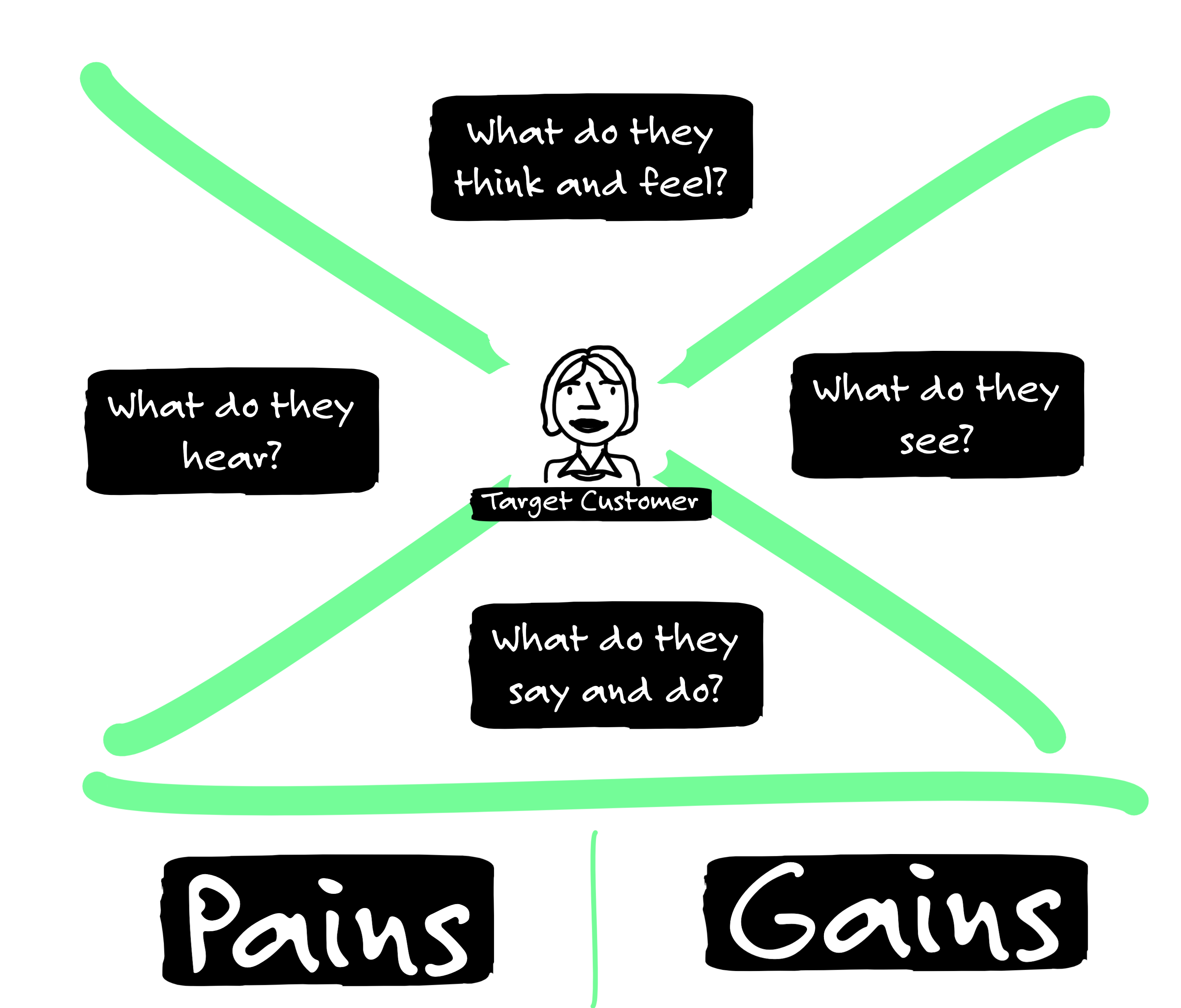
So let’s get to work. Use one empathy map for each of your customer personas and think about how to answer the following points, in relation to purchasing and using the product/service you want to offer.
- What do they think and feel? What are the things that really count to them, their major preoccupations, their worries, and their aspirations?
- What do they hear? What do friends, family, colleagues and other peers say?
- What do they see? What do they see in their environment, within their friends & family groups and what the market offers?
- What do they say and do? What are their actions and tasks, what statements do they make and how do they behave and appear in public?
- What are their pains? What are their fears, frustrations, obstacles?
- What are their gains? What are their wants, needs and measures of success?
☝️ Write down your answers on the post-its in each section of your empathy map on the Customer Deep Dive 📒Template.
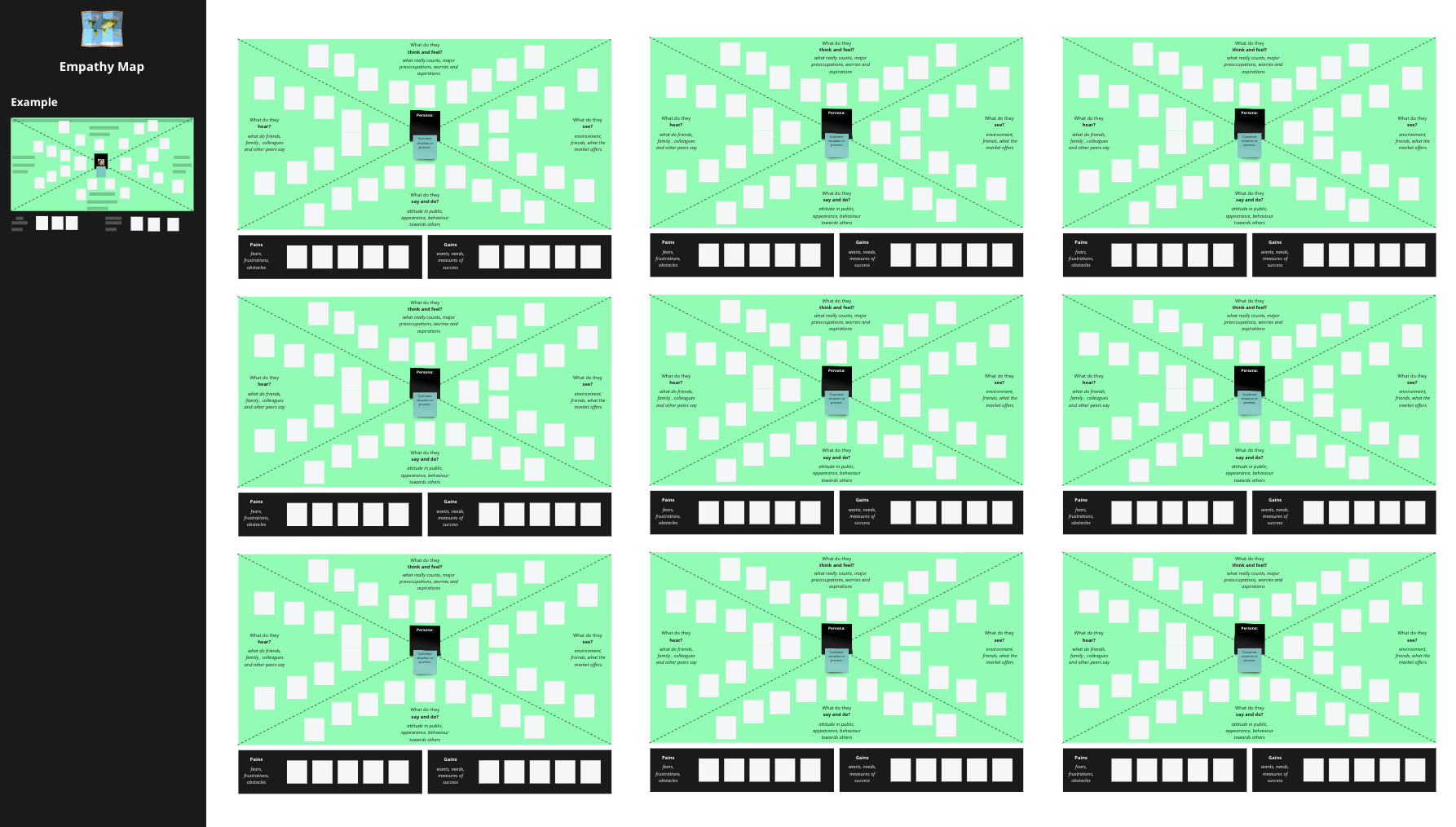
Step F
Customer Journey

Finally, you want to understand the journey from your customer personas’ point of view.
A customer journey is the complete set of experiences that a customer has with a business or brand, from the first time they become aware of it, to the final interaction they have with it. The customer journey typically includes a series of touchpoints or interactions, that a customer has with a business, such as visiting its website, engaging with its social media accounts, or visiting its physical storefront.
Describe for each of the personas that you defined, which touchpoints they pass, which actions they take or which pain- and gain points they encounter during each of the steps of the journey:

Put yourself in their shoes and think about how they could differ for each of them, depending on what you defined on your persona and empathy map.
☝️Use the customer journey section on your Customer Deep Dive 📒Template to note down your findings.
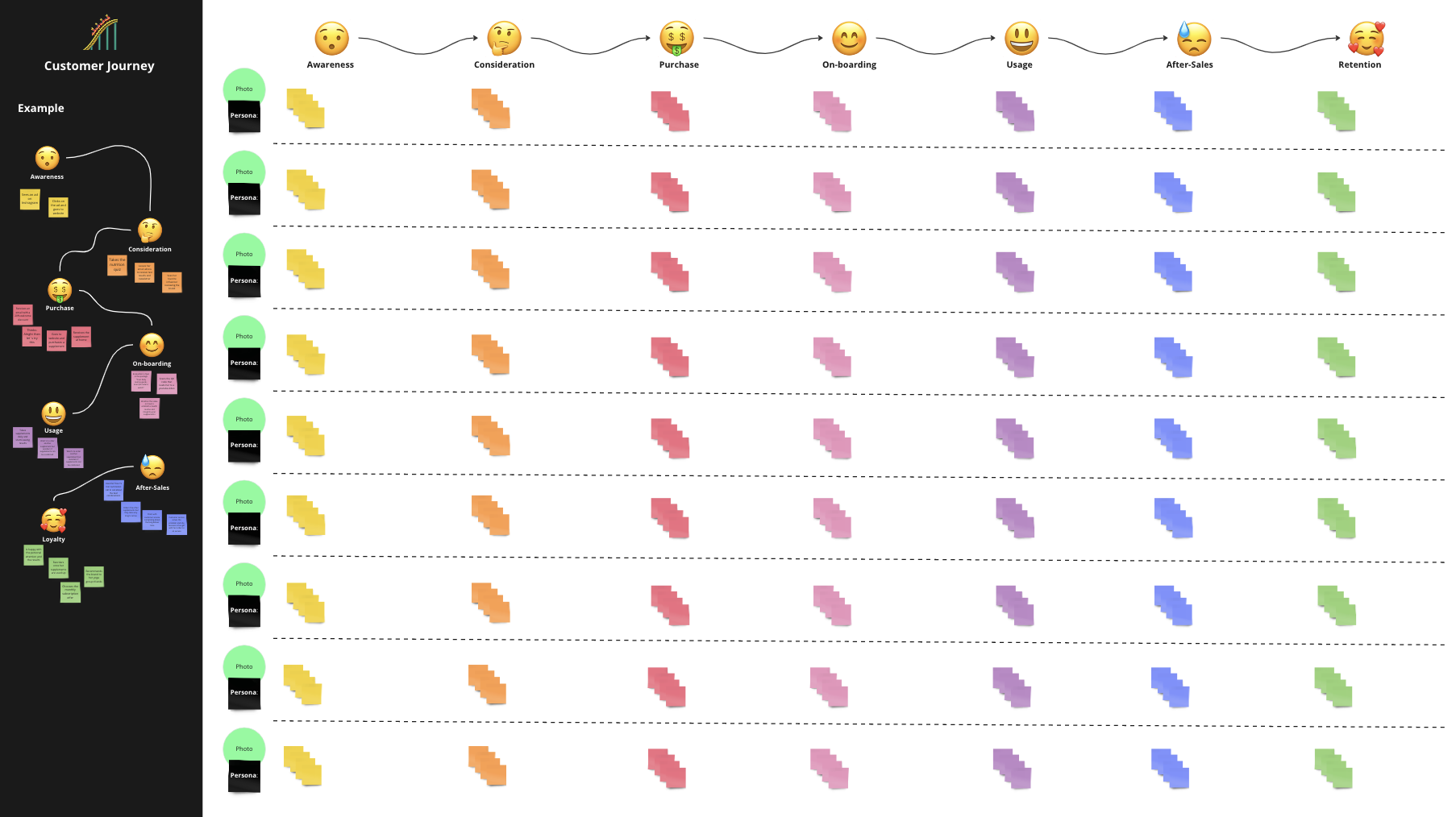
Step G
Market Research (optional)

Of course these customer profiles are mostly based on your own experience and imagination and probably the one of your peers. This is totally fine at this stage, but if you want to validate and confirm your assumptions, you can optionally conduct a quick customer survey.
This, however, will take longer than just a day since you will have to define and set up the survey, distribute it to potential interviewees, wait until enough people answered your survey and you got a reasonable sample size and finally analyze the results and draw your conclusions. You should plan with at least one week, depending on how fast you collect all the responses you need.
The number of survey responses required for the results to be statistically significant depends on a number of factors, including the size of the population being surveyed, the level of confidence desired, and the margin of error. However, since this survey merely serves the purpose of resolving your doubts and not to write a scientific paper, just define a minimum number of responses that you feel will provide you the confidence on your assumptions.
Now let’s look at how to conduct a customer survey in case you want to do so:
Be clear about the survey objectives
Before creating the survey, it’s important to clearly define its goals and objectives. This will help ensure that the survey is focused and relevant, and that the results are actionable. For example, the survey could be designed to assess customer interest in the new product, identify potential features or benefits that are most appealing to customers, or gauge customer willingness to pay for the product.
Depending on your overall objective, your survey can focus on gathering different types of information such as:
- Demographic: Ask respondents to provide information about themselves, such as their age, gender, income level, education level, etc.
- Knowledge: Assess a respondent’s knowledge or understanding of a particular topic or concept.
- Attitude: Assess a respondent’s feelings or opinions about a particular topic or issue.
- Behavior: Ask respondents to describe their past behavior or predict their future behavior in a particular situation.
- Needs assessment: Assess a respondent’s needs or priorities in a particular area or situation.
- Satisfaction: Assess a respondent’s level of satisfaction with a product, service, or experience.
☝️ Here is a spreadsheet 📒Template you can use to define your objectives and survey questionnaire. The template is pre-filled with example objectives and questions. You can, however, adapt those according to your specific needs. Use this template to first design your survey and then transfer it to the survey tool.
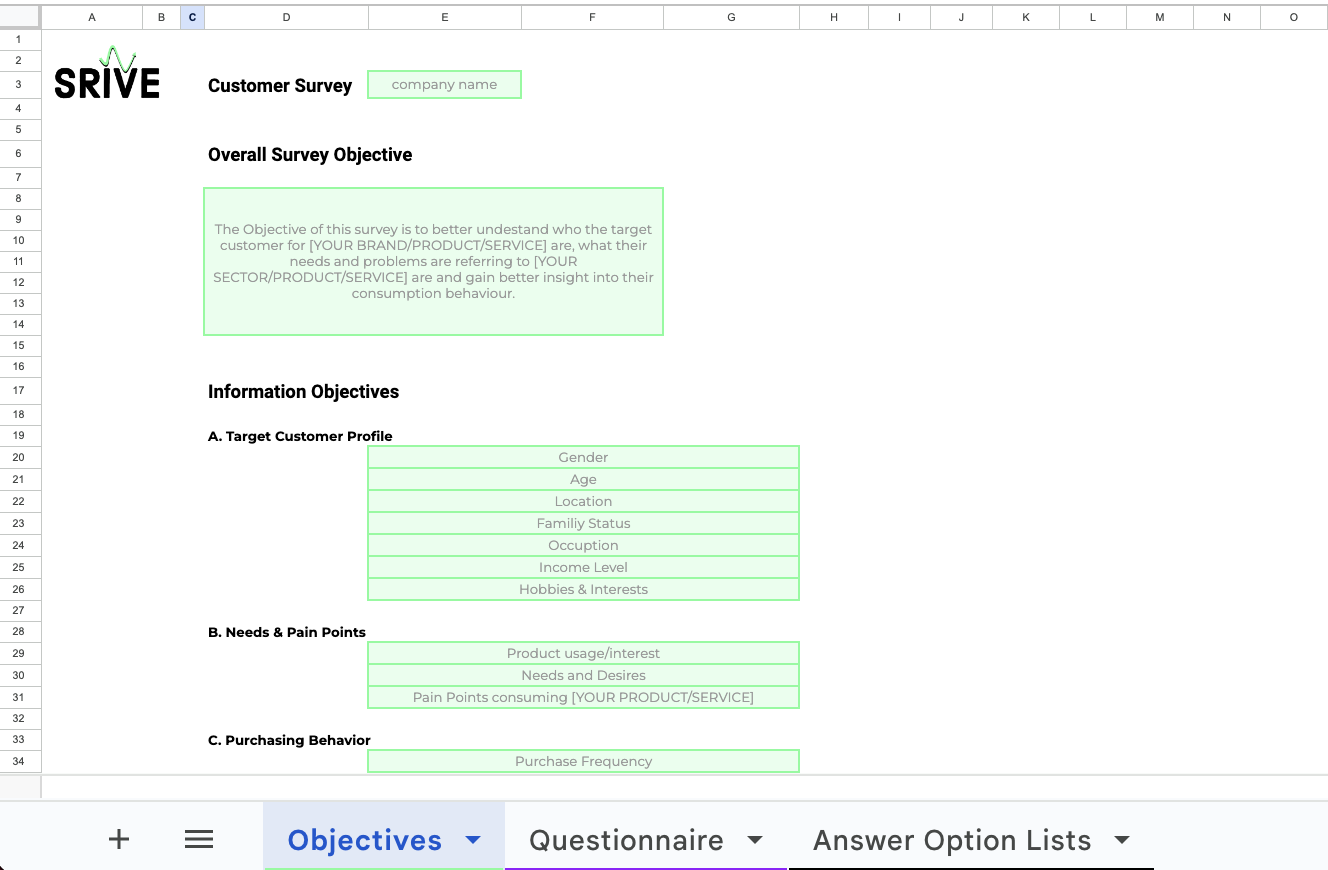
Develop a list of survey questions
Once the objectives of the survey are clear, the next step is to develop a list of survey questions that will help achieve those objectives. The questions should be clear, specific, and focused on the topic at hand. They should also provide a range of response options that allow respondents to provide detailed feedback. There are different formats of questions that you can use.
💡 You can find an overview of different types of survey question formats on the List above.
When designing the survey:
- Keep the survey short and focused: Surveys should be concise and cover only the most important topics. This will help ensure that respondents are able to complete the survey and provide meaningful feedback.
- Ask clear and specific questions: Make sure that each question is easy to understand and directly related to the topic at hand. Avoid using jargon or complex language, and provide clear instructions for answering each question.
- Offer multiple response options: Provide a variety of response options for each question, including multiple choice, Likert scale, and open-ended questions. This allows respondents to choose the option that best reflects their opinion and provide more detailed feedback.
Select the appropriate survey format and tool
There are several different formats that can be used for customer surveys, including online surveys, phone surveys, mail surveys, and in-person interviews. For this purpose, we will go with the online survey. There are a number of online survey tools out there that you can use, for example Google Forms. Most of them offer some kind of free version with different limitations. With those tools, you can easily build your survey base on the questions you defined and share the link to the survey.
💡 You can find a selection of survey tools on your Customer Research Tools List:
We used Google Forms, that is free, to create an example survey which you can view it here:
Test the survey
Before launching the survey, it’s important to test it to ensure that it is clear, concise, and easy to understand. Any issues or concerns that are identified during the testing phase should be addressed before the survey is sent to the full sample. You can do this by just asking your team members or even friends and family to complete the survey and give you quick feedback.
Distribute the survey
Once your survey is all set, it is time to distribute it. To ensure that your results are representative of your customer base, it’s important to use random sampling when selecting respondents for your survey. This will help ensure that the opinions of a diverse group of customers are represented in your results.
Some survey tools offer random customer samples that you can distribute your survey to, this can be, however, quite costly. So if you don’t have the budget to do this, you can just go with the DIY approach. Ask directly people in your network to complete the survey and send them the survey via email or messenger. Share the survey on your social media channels like Instagram, Twitter or Linked-in and ask your followers and contacts to respond to the survey. Ask your colleagues and pears to distribute the survey as well.
Collect and analyze the data
Once the survey is launched, the next step is to collect and analyze the data. The online survey tools usually allow you to export your result data to a CVS or Excel file, so this is the first thing you want to do. Once you have your data in your Excel, Google Sheet or whatever spreadsheet software you might use, you can go ahead and study those results. For very large data sets, you’ll probably need to use database software like SQL or Microsoft Access, but this probably won’t be the case here.
You can now analyze the answers of each stand-alone question, or you can cross the answers of, for example, profile questions with behavioral questions to analyze differences in the behavior of different customer segments.
There are a number of more sophisticated ways to analyze survey data, you will find descriptions of those methods below, in case you want to study them in more detail.
- Descriptive statistics: This method involves summarizing the data using measures such as mean, median, mode, and standard deviation to understand the general characteristics of the sample.
- Cross-tabulation: This method involves dividing the data into different categories or groups and comparing the responses across those groups to identify patterns or trends.
- Regression analysis: This method involves modeling the relationship between different variables to understand how changes in one variable affect the other.
- Factor analysis: This method involves identifying common underlying factors or themes in the data by reducing the number of variables and simplifying the data.
- Cluster analysis: This method involves dividing the data into different groups or clusters based on common characteristics or patterns.
- Sentiment analysis: This method involves using natural language processing techniques to automatically classify the sentiment of the responses as positive, negative, or neutral.
After conducting the survey, follow up with respondents to thank them for their feedback and let them know what actions you plan to take based on their responses. This will show that you value their input.
